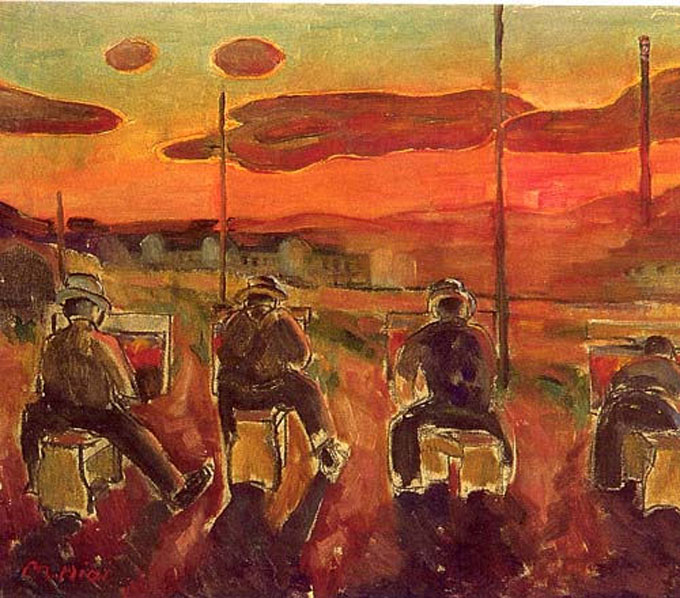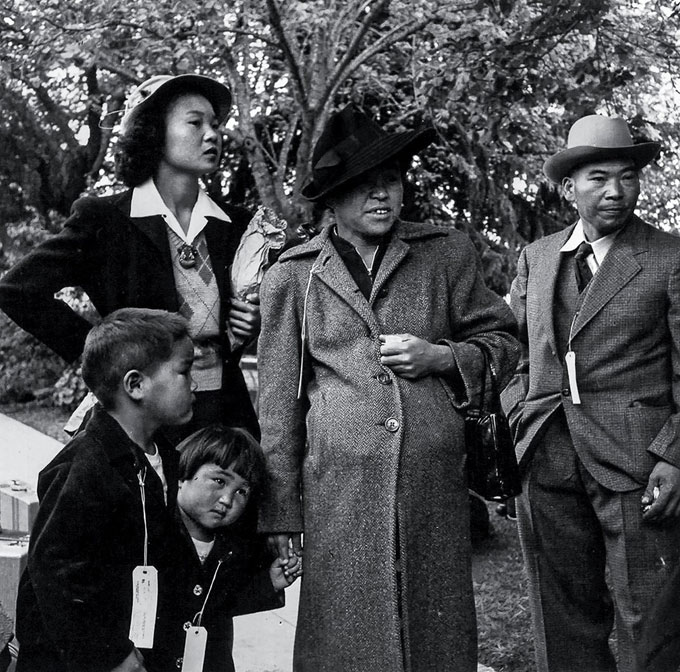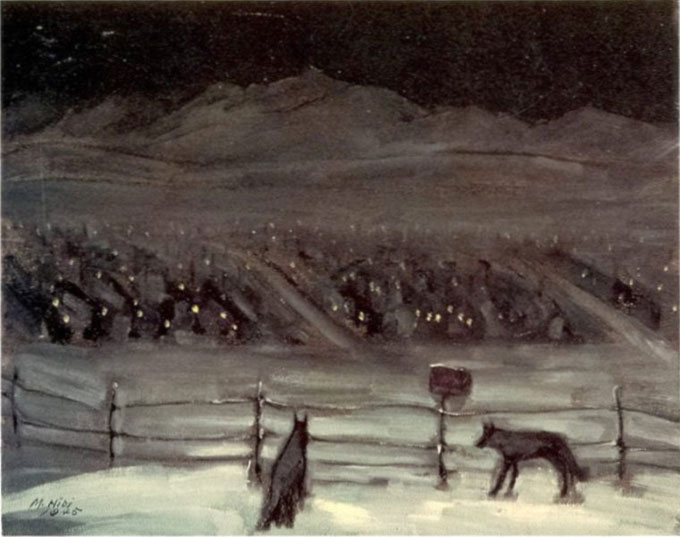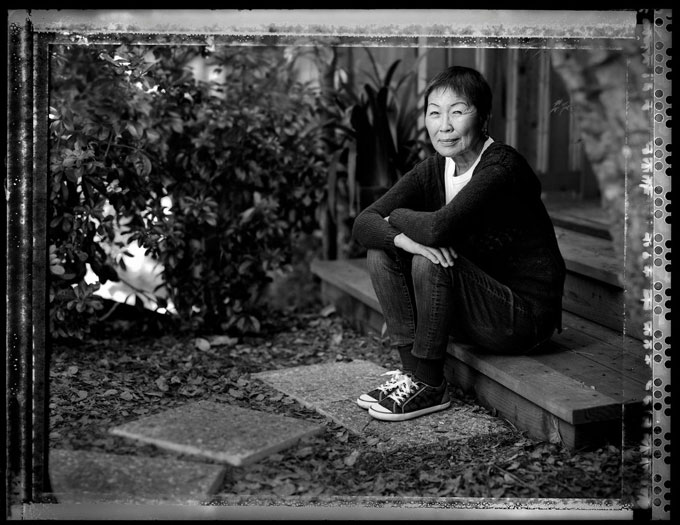The forced internment of 120,000 Japanese Americans two months after the bombing of Pearl Harbor distressed John Steinbeck, who admired Franklin Roosevelt, the president who signed the internment order. Today, exactly 75 years later, the memory of Executive Order 9066 continues to burden American history. An anniversary article on the World War II internment of Japanese Americans in the January 2017 issue of Smithsonian Magazine leads off with a profile of Jane Yanagi Diamond, a vibrant internment survivor I happen to know.
The 1942 photograph taken by Steinbeck’s ally and contemporary Dorothea Lange (above) shows Jane as a sorrowing child holding on to her pregnant mother’s hand, moments before the Yanagi family boards a bus on the way to the emergency assembly center hastily set up by the federal government at a California racetrack. The family was then sent to Topaz, an internment camp in Utah that would also house two exceptional California artists, Chiura Obata and George Matsusaburo Hibi. Obata, an art instructor at UC Berkeley, and Hibi, a prolific painter from Hayward, California, founded an art school at Topaz that uncovered hidden talent and helped internees cope until the war ended and they could go home.
Obata eventually returned to his teaching post at Cal and became famous for his Yosemite scenes. Hibi’s paintings included internment camp scenes like the one shown here. He was also magnanimous, donating 50 of his and his family paintings to the Hayward community before being sent to Topaz. Michael Brown, the author of Views from Asian California – 1920-1965, quotes Hibi as saying this about the gift: “There is no boundary in art. This is the only way I can show my appreciation to my many American friends here.’’ Obata died in 1975, Hibi in 1947, two years after his release from Topaz.
How Creating Art Helped Japanese Americans Survive
Obata and Hibi were part of a remarkable art movement in the Japanese American camps, most of which included professional artists who realized the importance of establishing a creative outlet for the internees. The work they produced–both professionals and students–was so moving, so powerful that in 1992 the Japanese American National Museum, the Wight Art Gallery at UCLA, and UCLA’s Asian American Studies Center assembled a landmark traveling exhibition, “The View from Within: Japanese American Art from the Internment Camps 1942-1945.” Hibi’s colorful painting of four Topaz internees seated at easels is testimony to the spirit of the movement he and Obata helped create.
Obata and Hibi were part of a remarkable art movement in the Japanese American camps, most of which included professional artists who realized the importance of establishing a creative outlet for the internees.
I was a reporter at the time, and I wrote several articles about the exhibition. My interest was initially stirred when I learned that a Japanese American artist named Miki Hayakawa was taken from my town of Pacific Grove, California, to an internment camp in Santa Fe, New Mexico. I knew Hayakawa was a superb artist because several of her exquisite paintings had come into the art gallery that my wife Nancy and I owned there. Hayakawa lived in Pacific Grove from 1939 until her removal to the camp and may well have known—or known of—John Steinbeck, who was in Pacific Grove off and on during that period. Hayakawa died in Santa Fe in 1953.
I was a reporter at the time, and I wrote several articles about the exhibition, ‘The World From Within: Japanese American Art from the Internment Camps, 1942-1945.’
I met Jane Yanagi Diamond (shown above at home) several years ago when she and her husband Tony came into the gallery. They live in Carmel and had a painting by Hibi that had hung at Topaz and that Hibi gave to Jane’s father when the family was released. Jane wanted to find a good home for the work and together we decided that it should return to Topaz, where a museum had been established to memorialize the internment of Japanese Americans like Jane. The piece was dramatic. Painted on four panels, it depicts three tigers stalking a brave antelope or gazelle, head down, determined to hold its ground in the face of an approaching threat. I wondered at the time if Hibi painted it to give children like Jane the courage they needed to go on.
I met Jane Yanagi Diamond when she and her husband Tony came into the gallery. They live in Carmel and had a painting by Hibi that had hung at the Topaz camp.
Jane developed a love of art, favoring the freedom of California plein air painting—work painted out of doors in an Impressionistic manner—and attending frequent art openings in and around Carmel with her husband. When an exhibition of Nancy’s paintings opened at the Pacific Grove Library several years ago, Tony and Jane were there. She recently shared a story about her father. “After Topaz,” she said, “whenever my father would get angry about something–sometimes something I might have done–I could always redirect his anger by mentioning Franklin Roosevelt because it brought back memories.”
Jane developed a love of art, favoring the freedom of California plein air painting and attending frequent art openings in and around Carmel with Tony. She recently shared a story about her father.
The Yanagi family also had the three tigers and the gazelle to help them hold onto a piece of personal history made less painful by art. But Hibi’s painting has now returned to Topaz, where it will continue to tell the story of artful courage and coping from a troubling episode in American history.
Photograph of Jane Yanagi Diamond by Paul Kitagaki Jr. courtesy Smithsonian Magazine.






If one were to simply consider what was presented in both articles, the Japanese citizens who were affected by the acts of our government at the time, if only due to the abandonment of our glorious Constitution may justify reparation and sincere apologies. But I see no mention of the complete political environment, intelligence information, and assumptions of President Franklyn Delano Roosevelt that prompted the marshall law executive order. For instance, there was plenty of evidence that espionage and other attacks by the government of Japan were imminent. These predictions were strong enough to conclude it wasn’t a matter of “if” they would attack but when. Reports from military service personnel who were stationed in Hawaii consistently reported that on the night before the surprise attack, Hawaiian taverns owned or managed by Japanese were particularly generous with dispensing liquor because the bartenders knew of the attack that would occur the following morning (December 7).
I see no mention In either article, of the fact that Japan also rounded up American, British, Dutch, and other non-Japanese and put them in camps operated by cruel and inhumane staff. No apology from Japan on this fact has happened. I know of no apologies or reparations for its other atrocities such as the Bataan Death march and etc. While Japan did not sign for the Geneva convention, their representatives did nod in agreement although their slave labor, starvation, and severe punishment raises doubt about their sincerity. The beheading of downed pilots following the Jimmy Doolittle’s Tokyo raid early in the war proves this fact. And what about Japanese Emporer Hirohito who, in my opinion, should have been hung right along side General Tojo? Was Hirohito not considered the supreme leader and God on earth? Of course he ultimately was responsible for all orders, policy, and dictates. Germany killed 7 million non-combat Jews, gypsies, and etc. Japan killed 12 million non-combat Chinese alone.
A real understanding of Steinbeck’s phalanx would support that war brings out the greatest evil in humanity. I believe the treatment of Japanse citizens incarcerated during the war was much kinder than the treatment received by non-Japanese and as a result no apologies should be expected. Politically, the situations were a wash.
Your points are well made and well taken. For context, see Steinbeck’s description of the environmental damage done by Japanese fishing fleets in ‘Sea of Cortez’ and his frustration at our government’s (wilful?) failure to use scientific data about the depth and face of the Pacific gathered (in English!) by the Japanese government prior to Pearl Harbor. After the war he signed a letter of welcome to the Japanese business community in Monterey–home of Fort Ord–where a strong Japanese presence existed and continues to this day.
When we were writing Doc’s Lab: Myths and Legends of Cannery Row i came across this story about how Ed Ricketts had, from reading the Japanese Marine Journals, (which apparently our government did not know existed) figured out that the studies were not done for habitat or species research. Instead they we studying the Pacific Island geography to gain an understanding of where landing barges could reach the beaches. Access corridors for each island. Ed suspected that these were studies that were leading up to an invasion of all of the Pacific Islands. When he and Steinbeck sent their findings to the Department of the Navy they were subsequently visited by two Navy Department personnel. They wanted to know the sources for their data and assumptions. Essentially they were suspected of being unAmerican for reading Japanese scientific journals. The government had in their hands 5 years before the invasion of Pearl Harbor elements of the master plan of the Japanese campaign in the Pacific. Ignored to our nations peril and to the lives of thousands.
My father, unmarried and 22, enlisted with the Army air corps shortly after Pearl Harbor and was stationed in London when Steinbeck was there. He is the first person in my memory who described the term ‘military intelligence’ as an oxymoron. Ricketts–a father, age 42, when he was drafted for service–had every reason to agree.
In preparation for the attack on Pearl Harbor with its relatively shallow depth, the Japanese closely observed a British torpedo attack in the harbor of Torrento, Italy. Japan solved the problem by attaching a simple wooden fin to the torpedo’s tail. This prevented the torpedo from sinking too deeply and exploding into the muddy harbor bottom. In my opinion, the Navy’s stubborn parochialism toward any outside suggestion was likely the cause of the suspicion toward Ricketts. I suppose his friendship with Steinbeck didn’t help as he was wrongly considered a communist. He was not a communist. You cannot simultaneously be a communist and an pure individualist.
In 1983, after two years of hearings around the country, testimony by 750 persons, including Japanese Americans, government officials, military leaders, Constitutional scholars, historians, etc, the Commission on Wartime Relocation and Internment of Civilians concluded in their report to Congress entitled “Personal Justice Denied,” that allegations such as the ones you raise to justify and rationalize the wholesale expulsion and incarceration of Japanese immigrants and American citizens of Japanese ancestry by race alone and without individual due process as guaranteed in the U.S. Constitution were not a justifiable basis for the U.S. run concentration camps. That report concludes that it was “wartime hysteria, racial prejudice, and the failure of political leadership” — most notably pandering to racist constituents, including those with a financial interest in seeing Japanese Americans moved out — that were the main causes of that shameful chapter in American history.
The courts were operating and there is no justification except blatant racism to imprison people like my parents — American citizens born in California who were attending public high schools at the time — and their long-time resident parents. No evidence was brought against Japanese Americans and thus no legal defense was allowed.
Trying to justify the racist treatment of Japanese Americans by citing actions of people other than themselves is the cornerstone of American racism — people of color have always been blamed for something that someone else of their race is accused of. Anti-Japanese racism was very strong and too few people stood up against it to defend the rights of almost 120,000 Japanese Americans to individual due process.
People should stop slinging rumors and unsubstantiated anecdotes that never stood the test of legal examination in a court of law. As a matter of fact several federal and military law enforcement and intelligence agencies weighed in against the mass round-up and incarceration — the FBI and the Office of Naval Intelligence — both of which had been surveilling the Japanese American community for years before WWII.
The findings of the CWRIC were accepted by Congress, and the reparations bill was passed by both houses of Congress and signed into law on August 10, 1988. If you’re still trying to argue in defense of the WWII U.S. concentration camps then you have only white supremacy on your side.
Hello, Susan,
I don’t think in any way was I arguing in defense of the concentration camps. They were reprehensible.
Steinbeck/Ricketts’ Sea of Cortez is my most used and tattered books and I do recall their mentioning of the Japanese and their huge factory ships.
There is no doubt about how the attack on Pearl Harbor clearly demonstrated our weaknesses – not the least of which was our understanding of the Japanese collective psychology, culture, history, and prevailing attitudes. So-called American ‘experts”, for instance predicted that Japanese would not produce any adequate pilots because they were carried on the backs of their mothers at an early age. They not only had great pilots but their aircraft, aside from the armament typical of British and American planes, were superior to our own at the beginning of the war. Culturally, Japan was a vertically managed society father figure followers much like Germany under Hitler. Blind and unquestioning obedience to the vertical authority was expected. But herein was the germ of defeat – they were no match for as Steinbeck pointed out in “Bombs Away…”, a population who had just struggled through a depression and unimaginable individual but psyche building suffering.
My father believed in a World Court..an International Congress for the promotion of World Peace,
with, hopefully,
The discernment and ability
to prevent, and or prosecute..
Leaders of State..
for Injustices and Crimes against Humanity.
Forgotten documents reveal views on return of Japanese internees to Monterey Peninsula
http://www.montereyherald.com/article/zz/20131109/NEWS/131108087
Steinbeck, Ed and Toni Ricketts and a host of other familiar names from the Monterey Peninsula signed the petition.